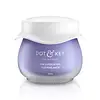What's inside
What's inside
 Key Ingredients
Key Ingredients

 Benefits
Benefits

 Concerns
Concerns

 Ingredients Side-by-side
Ingredients Side-by-side

Water
Skin ConditioningPropanediol
SolventGlycerin
HumectantMethyl Trimethicone
Skin ConditioningPhenyl Trimethicone
Skin ConditioningCaprylyl Methicone
Skin Conditioning1,2-Hexanediol
Skin ConditioningDicaprylyl Carbonate
EmollientSea Water
HumectantSaccharide Isomerate
HumectantHydrogenated Lecithin
EmulsifyingAmmonium Acryloyldimethyltaurate/Vp Copolymer
Hydrogenated Polyisobutene
EmollientHydroxyethyl Acrylate/Sodium Acryloyldimethyl Taurate Copolymer
Emulsion StabilisingCetearyl Alcohol
EmollientButylene Glycol
HumectantParfum
MaskingGlyceryl Caprylate
EmollientGlyceryl Stearate
EmollientStearic Acid
CleansingEthylhexylglycerin
Skin ConditioningDisodium EDTA
Acrylates/C10-30 Alkyl Acrylate Crosspolymer
Emulsion StabilisingTromethamine
BufferingSorbitan Isostearate
EmulsifyingPolyglyceryl-3 Methylglucose Distearate
EmulsifyingHyaluronic Acid
HumectantMagnesium Sulfate
Calcium Chloride
AstringentLinalool
PerfumingSodium Citrate
BufferingCitric Acid
BufferingHexyl Cinnamal
PerfumingBenzyl Salicylate
PerfumingButylphenyl Methylpropional
PerfumingLimonene
PerfumingBeta Vulgaris Root Extract
Skin ConditioningGeraniol
PerfumingCitronellol
PerfumingAlpha-Isomethyl Ionone
PerfumingManganese Sulfate
Skin ConditioningChenopodium Quinoa Seed Extract
Skin ConditioningTocopherol
AntioxidantZinc Sulfate
AntimicrobialLecithin
EmollientBrassica Oleracea Acephala Leaf Extract
HumectantNasturtium Officinale Extract
PerfumingGlycine Soja Oil
EmollientLepidium Sativum Sprout Extract
Skin ConditioningAscorbyl Glucoside
AntioxidantWater, Propanediol, Glycerin, Methyl Trimethicone, Phenyl Trimethicone, Caprylyl Methicone, 1,2-Hexanediol, Dicaprylyl Carbonate, Sea Water, Saccharide Isomerate, Hydrogenated Lecithin, Ammonium Acryloyldimethyltaurate/Vp Copolymer, Hydrogenated Polyisobutene, Hydroxyethyl Acrylate/Sodium Acryloyldimethyl Taurate Copolymer, Cetearyl Alcohol, Butylene Glycol, Parfum, Glyceryl Caprylate, Glyceryl Stearate, Stearic Acid, Ethylhexylglycerin, Disodium EDTA, Acrylates/C10-30 Alkyl Acrylate Crosspolymer, Tromethamine, Sorbitan Isostearate, Polyglyceryl-3 Methylglucose Distearate, Hyaluronic Acid, Magnesium Sulfate, Calcium Chloride, Linalool, Sodium Citrate, Citric Acid, Hexyl Cinnamal, Benzyl Salicylate, Butylphenyl Methylpropional, Limonene, Beta Vulgaris Root Extract, Geraniol, Citronellol, Alpha-Isomethyl Ionone, Manganese Sulfate, Chenopodium Quinoa Seed Extract, Tocopherol, Zinc Sulfate, Lecithin, Brassica Oleracea Acephala Leaf Extract, Nasturtium Officinale Extract, Glycine Soja Oil, Lepidium Sativum Sprout Extract, Ascorbyl Glucoside
Water
Skin ConditioningLactic Acid
BufferingCyclopentasiloxane
EmollientSodium Hydroxide
BufferingSilanetriol
Hyaluronic Acid
HumectantGlycerin
HumectantDimethicone
EmollientDimethicone Crosspolymer
Emulsion StabilisingDimethylsilanol Hyaluronate
HumectantPolyacrylate Crosspolymer-6
Emulsion StabilisingPEG-8
HumectantAnanas Sativus Fruit Extract
Skin ConditioningVitis Vinifera Seed Extract
AntimicrobialCucurbita Pepo Cotyledon Extract
Skin ConditioningBorago Officinalis Extract
EmollientXanthan Gum
EmulsifyingDisodium EDTA
Phenoxyethanol
PreservativeEthylhexylglycerin
Skin ConditioningOctenidine Hcl
AntimicrobialCI 42090
Cosmetic ColorantCI 45430
Cosmetic ColorantWater, Lactic Acid, Cyclopentasiloxane, Sodium Hydroxide, Silanetriol, Hyaluronic Acid, Glycerin, Dimethicone, Dimethicone Crosspolymer, Dimethylsilanol Hyaluronate, Polyacrylate Crosspolymer-6, PEG-8, Ananas Sativus Fruit Extract, Vitis Vinifera Seed Extract, Cucurbita Pepo Cotyledon Extract, Borago Officinalis Extract, Xanthan Gum, Disodium EDTA, Phenoxyethanol, Ethylhexylglycerin, Octenidine Hcl, CI 42090, CI 45430
 Reviews
Reviews

Ingredients Explained
These ingredients are found in both products.
Ingredients higher up in an ingredient list are typically present in a larger amount.
Disodium EDTA plays a role in making products more stable by aiding other preservatives.
It is a chelating agent, meaning it neutralizes metal ions that may be found in a product.
Disodium EDTA is a salt of edetic acid and is found to be safe in cosmetic ingredients.
Learn more about Disodium EDTAEthylhexylglycerin (we can't pronounce this either) is commonly used as a preservative and skin softener. It is derived from glyceryl.
You might see Ethylhexylglycerin often paired with other preservatives such as phenoxyethanol. Ethylhexylglycerin has been found to increase the effectiveness of these other preservatives.
Glycerin is already naturally found in your skin. It helps moisturize and protect your skin.
A study from 2016 found glycerin to be more effective as a humectant than AHAs and hyaluronic acid.
As a humectant, it helps the skin stay hydrated by pulling moisture to your skin. The low molecular weight of glycerin allows it to pull moisture into the deeper layers of your skin.
Hydrated skin improves your skin barrier; Your skin barrier helps protect against irritants and bacteria.
Glycerin has also been found to have antimicrobial and antiviral properties. Due to these properties, glycerin is often used in wound and burn treatments.
In cosmetics, glycerin is usually derived from plants such as soybean or palm. However, it can also be sourced from animals, such as tallow or animal fat.
This ingredient is organic, colorless, odorless, and non-toxic.
Glycerin is the name for this ingredient in American English. British English uses Glycerol/Glycerine.
Learn more about GlycerinHyaluronic acid is naturally found in healthy skin. It is a humectant, meaning it draws moisture to your skin.
This ingredient helps hydrate, soothe, and protect the skin.
What makes hyaluronic acid so hydrating? It has the capacity to bind or hold large amounts of water.
Fun fact: It is already naturally found in our bodies, such as the fluids of our eyes and our joints.
Studies find this ingredient to have anti-inflammatory and anti-microbial properties. This can help speed up wound-healing.
Hyaluronic acid can be irritating if the molecule has a low-molecular weight, or if the molecules are small.
One study found low-molecular weight hyaluronic acid to be pro-inflammatory, meaning some people may experience irritation. This is because our bodies use hyaluronic acid in the wound-healing process to signal to our bodies, via irritation, that something needs healing.
The same study found high-molecular weight hyaluronic acid to be anti-inflammatory.
These are some other common types of Hyaluronic Acid:
Learn more about Hyaluronic AcidWater. It's the most common cosmetic ingredient of all. You'll usually see it at the top of ingredient lists, meaning that it makes up the largest part of the product.
So why is it so popular? Water most often acts as a solvent - this means that it helps dissolve other ingredients into the formulation.
You'll also recognize water as that liquid we all need to stay alive. If you see this, drink a glass of water. Stay hydrated!
Learn more about Water